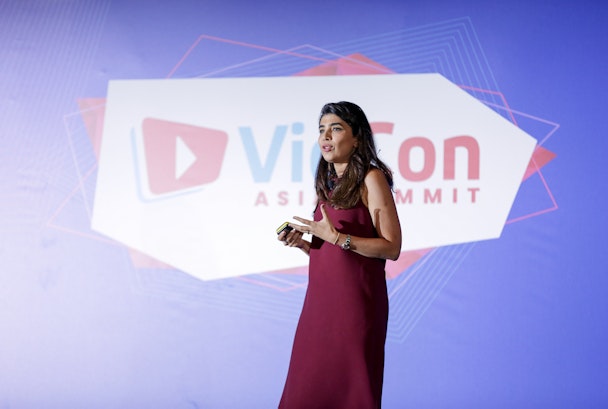Coca-Cola’s Sadaf Zarrar on ‘keeping it real’ by having a side hustle
Keeping up with what makes consumers tick is a full-time job, but it is also a side hustle for Coca-Cola’s director of integrated content and creative excellence for the Association of Southeast Asian Nations (ASEAN), Sadaf Zarrar.

Coca-Cola’s Sadaf Zarrar on ‘keeping it real’ by having a side hustle.
Zarrar is the lead on Coca-Cola’s content strategy in ASEAN but in her spare time, she runs SiddySays, a fashion and lifestyle blog in Pakistan. The SiddySays Instagram account has almost 200,000 followers, making it a significant side hustle.
Speaking to The Drum at Vidcon Asia, Zarrar says the two sit very separately but the skills learned on either side have become very complimentary.
“It's very complementary to what my experiences as a marketer are now working on the brand. I think that one of the things that I've often found myself struggling with, even now, is that marketing is evolving at such a fast pace. Sometimes, when you're just sitting in the office and just working on PowerPoints and branding, the pace of change is so quick that you can get a little detached," she explains.
“I think, even though my content creator hat isn't very big, what it does for me is it keeps it real. I know when and what platforms are en Vogue, so to speak, or where the engagement is sitting and what's up and coming."
She adds: "This is because when you're creating content, you are getting feedback in real-time - uncensored and unfiltered. I create content because I like creating content but what it does for me in my day job is it gives me a sense of where the market is going right now."
Expanding on this, Zarrar believes that the fundamental of marketing is connecting with people, so marketers should always be trying to be immersed in the places consumers are, not just theoretically.
“Every marketer needs to keep updated in terms of knowledge because, at the end of the day, our job is just reaching out to people and relating to people. There is no other science to it,” she says.
“It is very critical that we are up to date with whatever's going on in media and not just theoretically. It is why, if I meet a marketer who says, ‘Oh, I don't use social media’, I'm almost always surprised. Of course, it's a personal choice and everyone's welcome to do whatever, but it's our playing field. It is important, at least as an individual, to be there to kind of keep an eye on what's going on.”
Keeping abreast of consumer trends has often been a strong argument for the use of advertising agencies. As Zarrar explains, marketers can become too close to the business and lost in everyday tasks, or PowerPoints, so constant reminders of what consumers are really doing and feeling is a necessity.
It is one of the reasons Coca-Cola has not refuted the role of agencies to its business and still uses many agencies for its work around the world, while other brands pull back or consolidate. Zarrar explains that this is because brands are in need of outside specialisms as new techniques are needed.
“I can only comment on how Coke functions and because we have very small teams internally, agencies have essentially functioned for a very long time as partners. We refer to them because inevitably it's almost impossible to have certain skill sets hired internally," she says.
“I think it's interesting because the marketing industry generally goes through these cycles where everything becomes in-house and then everything goes outsourced and in-house again. I think we're at that point where, for example, if I talk about digital, the specialization is so immense, that is where agencies do come in."
She continues: "I think now more than ever, one needs specialist agencies and I think we're now working with more partner agencies than we've ever had before, historically. You have to be working with talent management agencies, production agencies, social media agencies, you name it,”
It is these specialists that will help the brand tackle its biggest challenges this year, of which Zarrar says the biggest is meaningfully fusing content creators and brands together. Currently, she says, it is difficult for brands to marry a creator’s audience authentically with a commercial message.
“I think we haven't quite cracked that, both as content creators as well as brands, in terms of where that sweet spot lies,” she adds.
As for how the industry can solve that, Zarrar believes patience is the key as that’s how authentic partnerships can be forged.
“A good example for Coca-Cola is around how we always talk about adding more happiness to this world and we've been talking about ‘Open Happiness’ or the ‘Coke Side of Life’ for a long time. For us to collaborate with a content creator that kind of has the same belief, it's very simple. It's a very good marriage in the making, but inevitably I think it just requires that time to understand each other and being able to authentically speak about that topic,” she explains.
Zarrar’s understanding of the nuance of this balance is undoubtedly helped by her being on the side of both the marketer and the content creator. Despite this being a major challenge for the industry, Zarrar and Coke are well-placed to tackle it.
She previously spoke to The Drum how Coke Studio is bringing the brand's value to life.
Content created with:

Coca Cola
Coca-Cola, or Coke, is a carbonated soft drink produced by The Coca-Cola Company. Originally intended as a patent medicine, it was invented in the late 19th century...
Find out more
